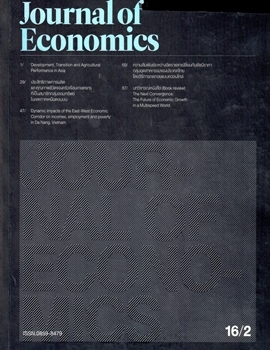Dynamic impacts of the East-West Economic Corridor on incomes, employment and poverty in Da Nang, Vietnam1
Keywords:
Impact study, highway, Vietnam, poverty, income distribution, การศึกษาผลกระทบ, เวียดนาม, ความยากจน, และการกระจายรายได้Abstract
The present study measures, explains, and compares the impacts of the first two years (2006 through 2008) of the Southeast Asian East-West Economic Corridor project on the level and distribution of incomes and the incidence, depth, and intensity of poverty in rural, semi-rural, and urban households in Da Nang province, Vietnam. Using t-tests, Gini coefficients, Foster-Thorbecke-Greer poverty indicators, and multiple regression analyses, we test six hypotheses.
Official statistics at the national level revealed that the road has conferred no clear advantage on Da Nang province when compared with other provinces, regions or cities within Vietnam. However, a micro-level within-province survey sample of 114 households demonstrates that proximity to the road had made people better off. Although transportation employment as a whole was not significantly correlated with income because skill levels required for that sector are variable, the transportation sector has provided new jobs to the poorest of the poor. Generally, the incidence and depth of poverty remain highest in the rural areas farthest from the road; while the semi-urban area closest to the road has witnessed the biggest decline in the incidence, depth and intensity of poverty. To redress inequities in accessing the advantages of the road, we recommend that the government provide human capital training to allow workers to qualify for higher-level jobs; special programs to aid small scale household enterprises; and more extensive health, education, and welfare programs for the poorest rural areas.
การศึกษาในครั้งนี้ต้องการศึกษาผลกระทบของโครงการพัฒนาแนวพื้นที่เศรษฐกิจตะวันออก-ตะวันตกที่มีต่อรายได้การจ้างงาน และความยากจนของครัวเรือนทั้งในพื้นที่ชนบท พื้นที่กึ่งเมืองกึ่งชนบท และพื้นที่ในเมือง จังหวัดดานัง ประเทศเวียดนาม โดยทดสอบสมมติฐานทั้งหมด 6 ข้อ โดยใช้ค่าสถิติ t ค่าสัมประสิทธิ์จีนี่ ค่าดัชนีความยากจนของ Foster-Thorbecke-Greer และการวิเคราะห์สมการถดถอย
จากสถิติในระดับประเทศแสดงให้เห็นว่าการสร้างถนนไม่ได้ให้ประโยชน์แก่จังหวัดดานัง เมื่อเปรียบเทียบกับจังหวัดอื่นๆ หรือภูมิภาคอื่นในเวียดนาม อย่างไรก็ตามการสำรวจข้อมูลระดับจุลภาคภายในจังหวัดจำนวน 114 ครัวเรือน พบว่าการสร้างถนนทำให้ผู้คนมีความเป็นอยู่ดีขึ้น ถึงแม้ว่าการจ้างงานในภาคการขนส่งจะไม่มีเกี่ยวข้องกับรายได้ อย่างมีนัยสำคัญ แต่ภาคการขนส่งสร้างงานให้กับกลุ่มผู้ที่ยากจนที่สุด อย่างไรก็ตามภาวะความยากจนยังคงปรากฏอยู่ โดยเฉพาะพื้นที่ชนบทที่ห่างไกลจากโครงการ ในขณะที่ความยากจนในพื้นที่กึ่งเมืองกึ่งชนบทลดลงมากที่สุด เพื่อแก้ปัญหาความไม่เท่าเทียมกันในการเข้าถึงโครงการดังกล่าว ผู้เขียนแนะนำให้รัฐบาลเพิ่มการลงทุนมนุษย์ เพื่อให้แรงงานสามารถ ทำงานคุณภาพสูงได้ส่งเสริมโครงการวิสาหกิจขนาดเล็ก และโครงการด้านสุขภาพ การศึกษาและสวัสดิการแก่ผู้ยากจนในพื้นที่ชนบท
Downloads
Issue
Section
License
All opinions and contents in the CMJE are the responsibility of the author(s). Chiang Mai University Journal of Economics reserves the copyright for all published materials. Papers may not be reproduced in any form without the written permission from Chiang Mai University Journal of Economics.
ข้อคิดเห็นที่ปรากฏและแสดงในเนื้อหาบทความต่างๆในวารสารเศรษฐศาสตร์มหาวิทยาลัยเชียงใหม่ ถือเป็นความเห็นและความรับผิดชอบโดยตรงของผู้เขียนบทความนั้นๆ มิใช่เป็นความเห็นและความรับผิดชอบใดๆของวารสารเศรษฐศาสตร์ มหาวิทยาลัยเชียงใหม่
บทความ เนื้อหา และข้อมูล ฯลฯ ในวารสารเศรษฐศาสตร์มหาวิทยาลัยเชียงใหม่ ถือเป็นลิขสิทธิ์เฉพาะของคณะเศรษฐศาสตร์มหาวิทยาลัยเชียงใหม่ หากบุคคลหรือหน่วยงานใดต้องการนำทั้งหมดหรือส่วนหนึ่งส่วนใดไปเผยแพร่ต่อหรือเพื่อกระทำการใดๆ จะต้องได้รับอนุญาตเป็นลายลักษณ์อักษร จากวารสารเศรษฐศาสตร์ มหาวิทยาลัยเชียงใหม่






